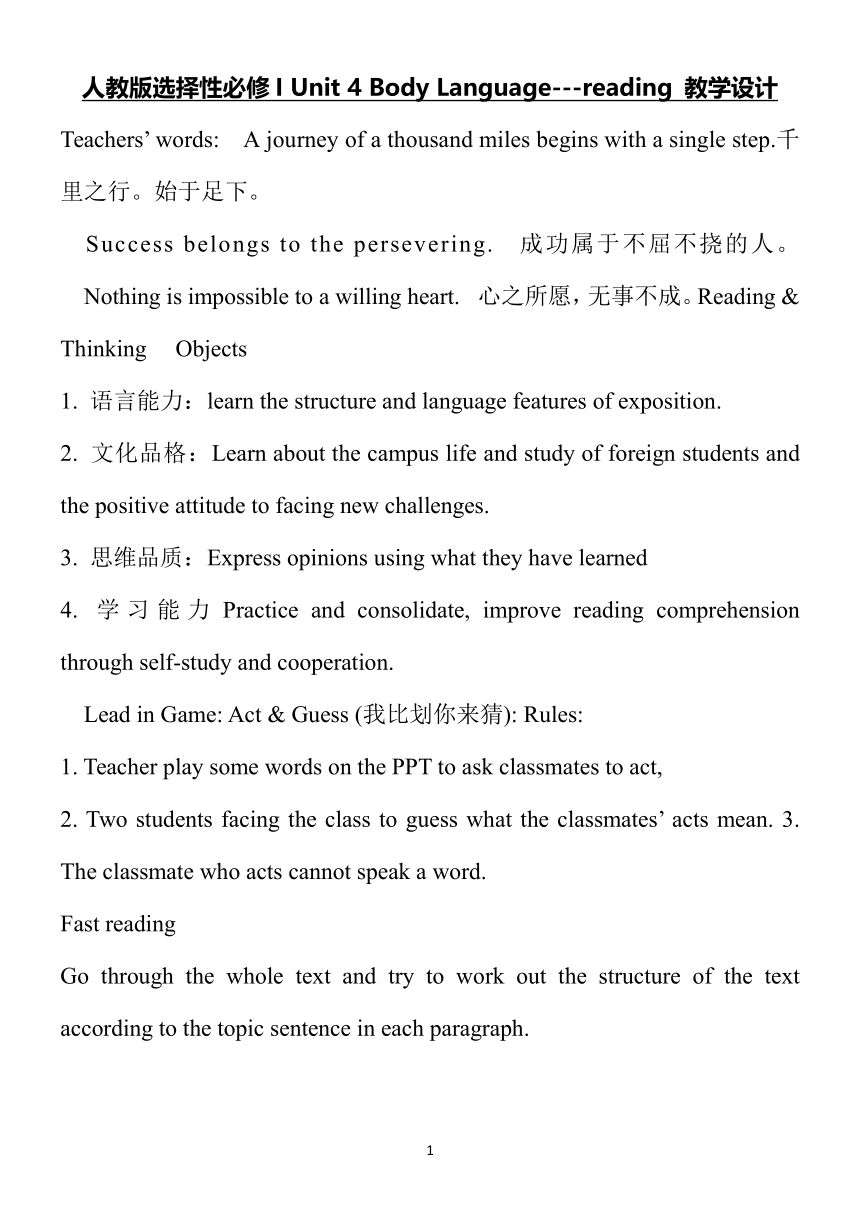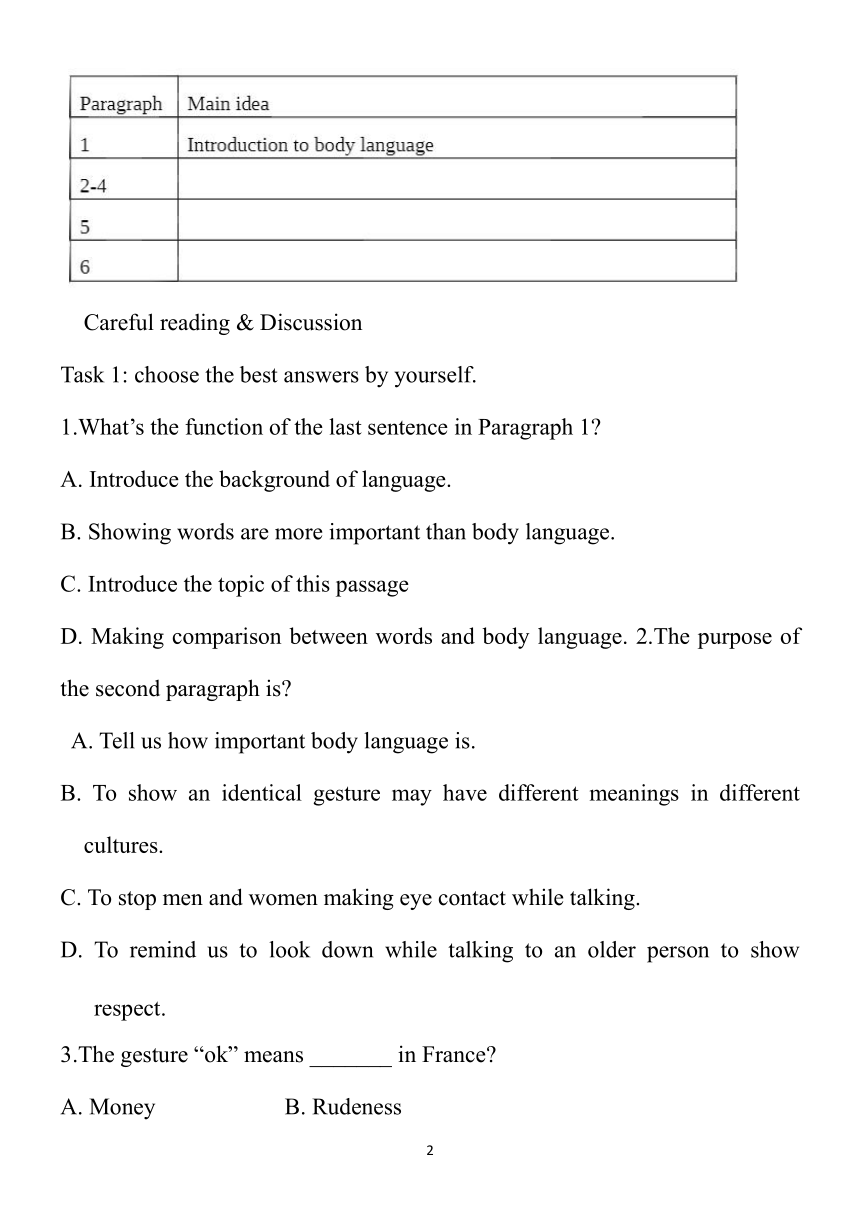人教版(2019)选择性必修 第一册Unit 4 Body Language---reading 教学设计
文档属性
| 名称 | 人教版(2019)选择性必修 第一册Unit 4 Body Language---reading 教学设计 |  | |
| 格式 | doc | ||
| 文件大小 | 72.2KB | ||
| 资源类型 | 教案 | ||
| 版本资源 | 人教版(2019) | ||
| 科目 | 英语 | ||
| 更新时间 | 2024-04-06 10:01:21 | ||
图片预览


文档简介
人教版选择性必修I Unit 4 Body Language---reading 教学设计
Teachers’ words:千里之行。始于足下。
成功属于不屈不挠的人。心之所愿,无事不成。Reading & Thinking
1. 语言能力:learn the structure and language features of exposition.
2. 文化品格:Learn about the campus life and study of foreign students and the positive attitude to facing new challenges.
3. 思维品质:Express opinions using what they have learned
4. 学习能力Practice and consolidate, improve reading comprehension through self-study and cooperation.
Game: Act & Guess (我比划你来猜): Rules:
1. Teacher play some words on the PPT to ask classmates to act,
2. Two students facing the class to guess what the classmates’ acts mean. 3. The classmate who acts cannot speak a word.
Fast reading
Go through the whole text and try to work out the structure of the text according to the topic sentence in each paragraph.
Task 1: choose the best answers by yourself.
1.What’s the function of the last sentence in Paragraph 1
A. Introduce the background of language.
B. Showing words are more important than body language.
C. Introduce the topic of this passage
D. Making comparison between words and body language. 2.The purpose of the second paragraph is
A. Tell us how important body language is.
B. To show an identical gesture may have different meanings in different cultures.
C. To stop men and women making eye contact while talking.
D. To remind us to look down while talking to an older person to show respect.
3.The gesture “ok” means _______ in France
A. Money B. Rudeness
C. Zero D. Favour.
4.Which statement does the author possibly agree with
A. Never too old to learn
B. Four eyes see more than two.
C. Every country has its own customs
D. When in Rome, do as Romans do.
Task 2: Fill the blanks
Task 3: answer the following questions by yourself and then discuss with your partners.
1、Go over the topic sentences in Para 2-5 and identify how each paragraph is developed. Discuss with your partner and draw a mind-map.
2、From the last paragraph, we know that smiling has different uses. Can you think of some other uses of smiling
(try to write more than 2 sentences)
1)A smile can...
2)We can use a smile to
3)Sb suggest smiling at/ sb suggest (that) smiling
4)There is nothing better than seeing the smiling face of ...when/if we are..
about feelings.However, it varies ___1___ culture to culture. For example, making eye contacttogether with the gesture for “ok”, “yes” and “no” ___2___(differ) around theworld. For example, in many Middle Eastern countries, men and women are not___3___(social) permitted to make eye contact. In Japan, it may show respect to look down when speaking with the older people. There are also differences in how we touch each other, how close we stand to someone we ___4___(talk) to and how we act when we meet or part. In countries like France and Russia, people may kiss their friends on ___5___cheek when they meet while in other countries of the world people approve of ___6___(shake) hands, bowing or nodding. Of course, some gestures have the same meaning everywhere. For example, placing hands together and resting them on the side of our head with our eyes closed means “sleep”. If we are full after a meal, we can move our hand in___7___(circle) over our stomach. On the other hand, some body language has many different uses. Perhaps the best example is smiling, ___8___ can help us get through difficult situations, find friends and break down barriers. You can also make ___9___(you) feel happier and stronger by smiling. If you feel down, there is nothing___10___(good) than seeing the smile of your good friend.
Role Play: 学生四人一组,一人扮演中国学生,另三人分别扮演来自日本、法国和中东的国际交流生。四人用肢体语言表演在机场初次见面和打招呼的场景。
Homework
Do you know other body languages which have different meanings in different countries Find out and share with us next class.
Teachers’ words:千里之行。始于足下。
成功属于不屈不挠的人。心之所愿,无事不成。Reading & Thinking
1. 语言能力:learn the structure and language features of exposition.
2. 文化品格:Learn about the campus life and study of foreign students and the positive attitude to facing new challenges.
3. 思维品质:Express opinions using what they have learned
4. 学习能力Practice and consolidate, improve reading comprehension through self-study and cooperation.
Game: Act & Guess (我比划你来猜): Rules:
1. Teacher play some words on the PPT to ask classmates to act,
2. Two students facing the class to guess what the classmates’ acts mean. 3. The classmate who acts cannot speak a word.
Fast reading
Go through the whole text and try to work out the structure of the text according to the topic sentence in each paragraph.
Task 1: choose the best answers by yourself.
1.What’s the function of the last sentence in Paragraph 1
A. Introduce the background of language.
B. Showing words are more important than body language.
C. Introduce the topic of this passage
D. Making comparison between words and body language. 2.The purpose of the second paragraph is
A. Tell us how important body language is.
B. To show an identical gesture may have different meanings in different cultures.
C. To stop men and women making eye contact while talking.
D. To remind us to look down while talking to an older person to show respect.
3.The gesture “ok” means _______ in France
A. Money B. Rudeness
C. Zero D. Favour.
4.Which statement does the author possibly agree with
A. Never too old to learn
B. Four eyes see more than two.
C. Every country has its own customs
D. When in Rome, do as Romans do.
Task 2: Fill the blanks
Task 3: answer the following questions by yourself and then discuss with your partners.
1、Go over the topic sentences in Para 2-5 and identify how each paragraph is developed. Discuss with your partner and draw a mind-map.
2、From the last paragraph, we know that smiling has different uses. Can you think of some other uses of smiling
(try to write more than 2 sentences)
1)A smile can...
2)We can use a smile to
3)Sb suggest smiling at/ sb suggest (that) smiling
4)There is nothing better than seeing the smiling face of ...when/if we are..
about feelings.However, it varies ___1___ culture to culture. For example, making eye contacttogether with the gesture for “ok”, “yes” and “no” ___2___(differ) around theworld. For example, in many Middle Eastern countries, men and women are not___3___(social) permitted to make eye contact. In Japan, it may show respect to look down when speaking with the older people. There are also differences in how we touch each other, how close we stand to someone we ___4___(talk) to and how we act when we meet or part. In countries like France and Russia, people may kiss their friends on ___5___cheek when they meet while in other countries of the world people approve of ___6___(shake) hands, bowing or nodding. Of course, some gestures have the same meaning everywhere. For example, placing hands together and resting them on the side of our head with our eyes closed means “sleep”. If we are full after a meal, we can move our hand in___7___(circle) over our stomach. On the other hand, some body language has many different uses. Perhaps the best example is smiling, ___8___ can help us get through difficult situations, find friends and break down barriers. You can also make ___9___(you) feel happier and stronger by smiling. If you feel down, there is nothing___10___(good) than seeing the smile of your good friend.
Role Play: 学生四人一组,一人扮演中国学生,另三人分别扮演来自日本、法国和中东的国际交流生。四人用肢体语言表演在机场初次见面和打招呼的场景。
Homework
Do you know other body languages which have different meanings in different countries Find out and share with us next class.
